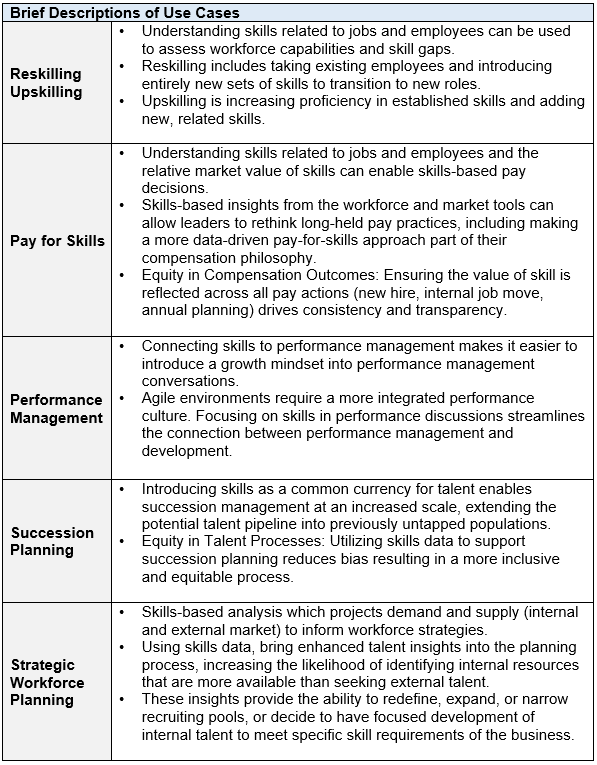As we enter the next phase of the pandemic, organizations are looking for answers on how to adapt to new economic realities, employee value propositions, and ways of working. In our experience, many organizations believe the answer to these challenges – lies in managing organizational capabilities and subsequent reskilling to align talent with organization needs.
Despite this need, many organizations who lack access to good information are finding it challenging to make timely decisions about how to reskill, who to recruit, and whether to outsource for a particular skill set. According to Mercer research, two in five HR leaders acknowledge they don’t know what skills they have in their workforce today and—just as concerning—only one in three are quantifying their skills gap against business objectives (“Global Talent Trends 2020”, Mercer). So, as organizations plan their next strategic iteration, they’re finding that a lack of real data on skills in their organization lessens their ability to make the informed strategic workforce decisions needed to spur transformation.
To drive accelerated business transformation post-pandemic, organizations are increasingly looking to advance career development and pay-for-skill strategies. To execute these strategies, robust Cloud-HCM and other data resources and technology are required. The success of these endeavors is dependent on job architecture and a library of skills data that are typically housed in ERP HCM systems like Workday, SuccessFactors, and Oracle.
The article “Cloud HCM Deployment and Job Architecture” (IHRIM, March 2019) described why a well-designed job architecture, or the framework by which jobs are organized, is one of the foundational elements underpinning Cloud HCM systems. In many ways, it explained, a job architecture is similar to the essential systems, like plumbing and electrical systems, that support a well-functioning home. Continuing that metaphor, skills are the natural gas or electrical current that flow through the plumbing and electrical systems to power the appliances we use to enhance the quality of our lives.
Jobs are a collection of skills, tasks, and responsibilities. Skills are the abilities, knowledge, and capabilities needed to fulfill job requirements. While job architecture organizes jobs and makes them easier to convey and manage, having skills tied to jobs within that architecture creates a common currency of content across talent-centric programs for employees, management, and HR. Enabled by a job architecture, the addition of data on skills deepens the ability to manage talent in the organization.
Skills are central to enabling successful and accelerated business transformation and optimal talent management in an agile and constantly evolving environment. Figure 1 provides several brief use cases that illustrate how the skills data, housed within HCM systems, in addition to other skills content and technology resources, can be used to improve business and HR process outcomes. While the relevance of each use case will differ by organization, the criticality of a robust job architecture and data on skills is consistently high across each of the use cases and therefore, similar to the 2019 article, Cloud HCM Deployment and Job Architecture, the importance of job architecture remains important as it has ever been.
As organizations adapt to the new shape of work, successful outcomes will depend on the ability to align their job architecture framework with a job skills taxonomy that supports the overall goal of building a future-proof business.

Elements of a Job Architecture plus Skills
A job architecture is a system used to define the internal organization of jobs. A job architecture provides a mechanism to accommodate an organization’s ever-changing collection of jobs. The elements of a job architecture include:
Career Streams
- Represents career types within the organization characterized by unique responsibilities.
- Created to offer alternatives for career progression within the four career streams. Common career streams include Executive, Management, Professional (Individual Contributor), Support, and Technical.
Career Levels
- Represents the hierarchy of work –– e.g., entry, intermediate, specialist, expert, and identifies the number of levels
- within each of the career streams. Recognizes incremental changes in job scope and responsibilities.
Job families and sub-families
- Describes the disciplines and sub-disciplines of work, such as Human Resources and Compensation respectively.
- Depending on actual roles and levels, the architecture for each job family will be shaped differently.
Skills
- The abilities or knowledge possessed by a person, which may be required to perform a task, assignment, gig, job, or role.
- Examples include Auditing, Benchmarking, Data Analysis, Data Governance, Job Analysis, Market Analysis, etc.
Elements of a Job Architecture plus Skills
A job architecture is a system used to define the internal organization of jobs. A job architecture provides a mechanism to accommodate an organization’s ever-changing collection of jobs. The elements of a job architecture include:






